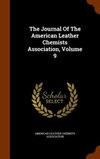Development of Leather Cutting Board from Plastic Waste
IF 0.5
4区 工程技术
Q4 CHEMISTRY, APPLIED
Journal of The American Leather Chemists Association
Pub Date : 2021-12-01
DOI:10.34314/jalca.v116i12.4689
引用次数: 1
Abstract
Cutting is the process in which goods or garment material are cut and converted into pattern shapes of the goods or garment components. There are two methods of Leather cutting, which are hand cutting and machine cutting. Hand cutting is done with the use of hand knife, cutting board and cutting patterns. Machine cutting can be done using semi-automatic cutting machines or fully-automatic cutting machines. Currently, in Ethiopia, different local and foreign investors are participating in leather products manufacturing. Most of the leather product manufacturing industry and some Small and Medium enterprise’s (SME’s) in the country are using leather cutting machines in order to cut leather goods or garment parts. Most of the industry and SMEs are using imported cutting board made of plastics and rubbers. However, these cutting boards are expensive. This research aimed at developing a cutting board made from HDPE (High-Density Polyethylene) plastic waste as main material, calcium carbonate as a filler and glass fiber as a reinforcing material. Primary and secondary data gathering techniques were applied simultaneously. Primary data were collected through interview and field observation. Secondary data was gathered by reviewing different literature. The cutting board developed through collecting HDPE plastic waste, washing, shredding and melting the shredded plastic with filler and reinforcing material. The melted plastic poured in to cutting board mold and cooled. The developed cutting board was compared with HDPE cutting board available in the local market. The developed board showed relative compression and hardness properties with the HDPE cutting board available in the market. In the cost analysis, the developed cutting board is cheaper than the cutting board which available in the market. However, the cutting board in the market has better surface texture and quality than the developed cutting board. Melting HDPE plastic waste using metal or clay cooking pots and charcoal fire is a tedious task and smoke from the fire will cause human health problem and will affect environment. Consequently, manual plastic melting method is not feasible for mass production, because it is difficult to control the amount of heat (charcoal fire) during melting process. Based on this the authors recommend using machine based plastic melting and molding during HDPE and related plastic recycling.利用废旧塑料开发皮革砧板
裁剪是将商品或服装材料裁剪成商品或服装部件的图案形状的过程。皮革切割有两种方法,即手工切割和机器切割。手工切割是使用手刀,砧板和切割图案完成的。机器切割可采用半自动切割机或全自动切割机进行。目前,在埃塞俄比亚,不同的本地和外国投资者正在参与皮革制品制造。国内大多数皮革制品制造业和一些中小型企业都在使用皮革切割机来切割皮革制品或服装零件。大多数行业和中小企业都使用进口的塑料和橡胶制成的砧板。然而,这些砧板很贵。本研究以HDPE(高密度聚乙烯)塑料废料为主要材料,碳酸钙为填料,玻璃纤维为增强材料,研制出一种菜板。主要和次要数据收集技术同时应用。通过访谈和实地观察收集初步资料。通过查阅不同文献收集辅助资料。该砧板是通过收集HDPE塑料废料,将切碎的塑料与填料和增强材料进行洗涤、切碎和熔化而开发的。融化的塑料倒入切菜板模具冷却。将所研制的菜板与国内市场上的HDPE菜板进行了比较。所开发的板具有与市场上现有的HDPE砧板相对的压缩性能和硬度。在成本分析上,开发的菜板比市场上现有的菜板便宜。但是,市场上的菜板比发达的菜板具有更好的表面质感和质量。使用金属或粘土锅和炭火熔化HDPE塑料废物是一项繁琐的任务,并且火灾产生的烟雾会造成人体健康问题并影响环境。因此,人工塑料熔炼方法不适合大规模生产,因为熔炼过程中的热量(炭火)难以控制。在此基础上,作者建议在HDPE和相关塑料回收中使用机器熔融和成型。
本文章由计算机程序翻译,如有差异,请以英文原文为准。
求助全文
约1分钟内获得全文
求助全文
来源期刊

Journal of The American Leather Chemists Association
工程技术-材料科学:纺织
CiteScore
1.30
自引率
33.30%
发文量
29
审稿时长
3 months
期刊介绍:
The Journal of the American Leather Chemists Association publishes manuscripts on all aspects of leather science, engineering, technology, and economics, and will consider related subjects that address concerns of the industry. Examples: hide/skin quality or utilization, leather production methods/equipment, tanning materials/leather chemicals, new and improved leathers, collagen studies, leather by-products, impacts of changes in leather products industries, process efficiency, sustainability, regulatory, safety, environmental, tannery waste management and industry economics.
 求助内容:
求助内容: 应助结果提醒方式:
应助结果提醒方式:


